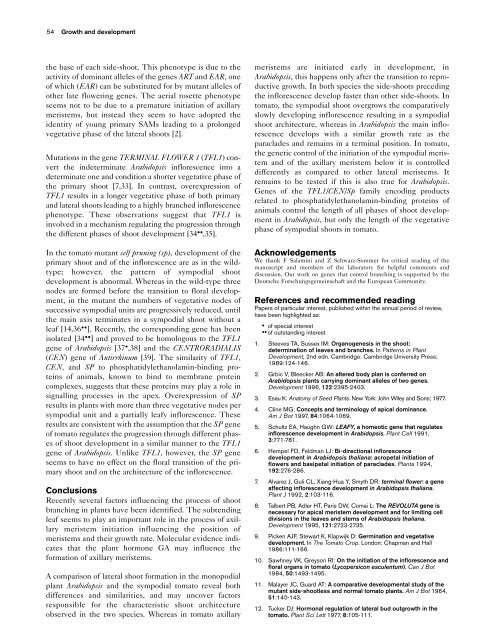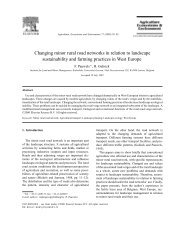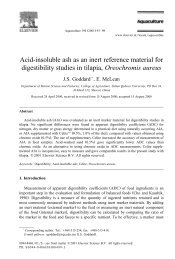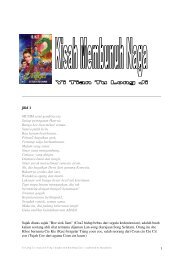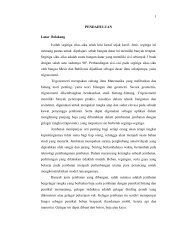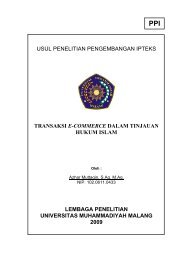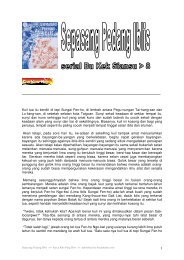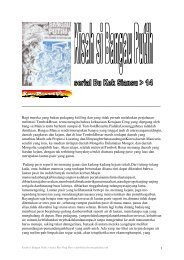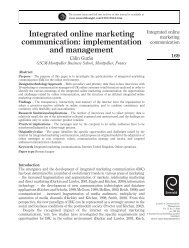Genetic control of branching in Arabidopsis and ... - Directory UMM
Genetic control of branching in Arabidopsis and ... - Directory UMM
Genetic control of branching in Arabidopsis and ... - Directory UMM
Create successful ePaper yourself
Turn your PDF publications into a flip-book with our unique Google optimized e-Paper software.
54 Growth <strong>and</strong> development<br />
the base <strong>of</strong> each side-shoot. This phenotype is due to the<br />
activity <strong>of</strong> dom<strong>in</strong>ant alleles <strong>of</strong> the genes ART <strong>and</strong> EAR, one<br />
<strong>of</strong> which (EAR) can be substituted for by mutant alleles <strong>of</strong><br />
other late flower<strong>in</strong>g genes. The aerial rosette phenotype<br />
seems not to be due to a premature <strong>in</strong>itiation <strong>of</strong> axillary<br />
meristems, but <strong>in</strong>stead they seem to have adopted the<br />
identity <strong>of</strong> young primary SAMs lead<strong>in</strong>g to a prolonged<br />
vegetative phase <strong>of</strong> the lateral shoots [2].<br />
Mutations <strong>in</strong> the gene TERMINAL FLOWER 1 (TFL1) convert<br />
the <strong>in</strong>determ<strong>in</strong>ate <strong>Arabidopsis</strong> <strong>in</strong>florescence <strong>in</strong>to a<br />
determ<strong>in</strong>ate one <strong>and</strong> condition a shorter vegetative phase <strong>of</strong><br />
the primary shoot [7,33]. In contrast, overexpression <strong>of</strong><br />
TFL1 results <strong>in</strong> a longer vegetative phase <strong>of</strong> both primary<br />
<strong>and</strong> lateral shoots lead<strong>in</strong>g to a highly branched <strong>in</strong>florescence<br />
phenotype. These observations suggest that TFL1 is<br />
<strong>in</strong>volved <strong>in</strong> a mechanism regulat<strong>in</strong>g the progression through<br />
the different phases <strong>of</strong> shoot development [34 •• ,35].<br />
In the tomato mutant self prun<strong>in</strong>g (sp), development <strong>of</strong> the<br />
primary shoot <strong>and</strong> <strong>of</strong> the <strong>in</strong>florescence are as <strong>in</strong> the wildtype;<br />
however, the pattern <strong>of</strong> sympodial shoot<br />
development is abnormal. Whereas <strong>in</strong> the wild-type three<br />
nodes are formed before the transition to floral development,<br />
<strong>in</strong> the mutant the numbers <strong>of</strong> vegetative nodes <strong>of</strong><br />
successive sympodial units are progressively reduced, until<br />
the ma<strong>in</strong> axis term<strong>in</strong>ates <strong>in</strong> a sympodial shoot without a<br />
leaf [14,36 •• ]. Recently, the correspond<strong>in</strong>g gene has been<br />
isolated [34 •• ] <strong>and</strong> proved to be homologous to the TFL1<br />
gene <strong>of</strong> <strong>Arabidopsis</strong> [37 • ,38] <strong>and</strong> the CENTRORADIALIS<br />
(CEN) gene <strong>of</strong> Antirrh<strong>in</strong>um [39]. The similarity <strong>of</strong> TFL1,<br />
CEN, <strong>and</strong> SP to phosphatidylethanolam<strong>in</strong>-b<strong>in</strong>d<strong>in</strong>g prote<strong>in</strong>s<br />
<strong>of</strong> animals, known to b<strong>in</strong>d to membrane prote<strong>in</strong><br />
complexes, suggests that these prote<strong>in</strong>s may play a role <strong>in</strong><br />
signall<strong>in</strong>g processes <strong>in</strong> the apex. Overexpression <strong>of</strong> SP<br />
results <strong>in</strong> plants with more than three vegetative nodes per<br />
sympodial unit <strong>and</strong> a partially leafy <strong>in</strong>florescence. These<br />
results are consistent with the assumption that the SP gene<br />
<strong>of</strong> tomato regulates the progression through different phases<br />
<strong>of</strong> shoot development <strong>in</strong> a similar manner to the TFL1<br />
gene <strong>of</strong> <strong>Arabidopsis</strong>. Unlike TFL1, however, the SP gene<br />
seems to have no effect on the floral transition <strong>of</strong> the primary<br />
shoot <strong>and</strong> on the architecture <strong>of</strong> the <strong>in</strong>florescence.<br />
Conclusions<br />
Recently several factors <strong>in</strong>fluenc<strong>in</strong>g the process <strong>of</strong> shoot<br />
<strong>branch<strong>in</strong>g</strong> <strong>in</strong> plants have been identified. The subtend<strong>in</strong>g<br />
leaf seems to play an important role <strong>in</strong> the process <strong>of</strong> axillary<br />
meristem <strong>in</strong>itiation <strong>in</strong>fluenc<strong>in</strong>g the position <strong>of</strong><br />
meristems <strong>and</strong> their growth rate. Molecular evidence <strong>in</strong>dicates<br />
that the plant hormone GA may <strong>in</strong>fluence the<br />
formation <strong>of</strong> axillary meristems.<br />
A comparison <strong>of</strong> lateral shoot formation <strong>in</strong> the monopodial<br />
plant <strong>Arabidopsis</strong> <strong>and</strong> the sympodial tomato reveal both<br />
differences <strong>and</strong> similarities, <strong>and</strong> may uncover factors<br />
responsible for the characteristic shoot architecture<br />
observed <strong>in</strong> the two species. Whereas <strong>in</strong> tomato axillary<br />
meristems are <strong>in</strong>itiated early <strong>in</strong> development, <strong>in</strong><br />
<strong>Arabidopsis</strong>, this happens only after the transition to reproductive<br />
growth. In both species the side-shoots preced<strong>in</strong>g<br />
the <strong>in</strong>florescence develop faster than other side-shoots. In<br />
tomato, the sympodial shoot overgrows the comparatively<br />
slowly develop<strong>in</strong>g <strong>in</strong>florescence result<strong>in</strong>g <strong>in</strong> a sympodial<br />
shoot architecture, whereas <strong>in</strong> <strong>Arabidopsis</strong> the ma<strong>in</strong> <strong>in</strong>florescence<br />
develops with a similar growth rate as the<br />
paraclades <strong>and</strong> rema<strong>in</strong>s <strong>in</strong> a term<strong>in</strong>al position. In tomato,<br />
the genetic <strong>control</strong> <strong>of</strong> the <strong>in</strong>itiation <strong>of</strong> the sympodial meristem<br />
<strong>and</strong> <strong>of</strong> the axillary meristem below it is <strong>control</strong>led<br />
differently as compared to other lateral meristems. It<br />
rema<strong>in</strong>s to be tested if this is also true for <strong>Arabidopsis</strong>.<br />
Genes <strong>of</strong> the TFL1/CEN/Sp family encod<strong>in</strong>g products<br />
related to phosphatidylethanolam<strong>in</strong>-b<strong>in</strong>d<strong>in</strong>g prote<strong>in</strong>s <strong>of</strong><br />
animals <strong>control</strong> the length <strong>of</strong> all phases <strong>of</strong> shoot development<br />
<strong>in</strong> <strong>Arabidopsis</strong>, but only the length <strong>of</strong> the vegetative<br />
phase <strong>of</strong> sympodial shoots <strong>in</strong> tomato.<br />
Acknowledgements<br />
We thank F Salam<strong>in</strong>i <strong>and</strong> Z Schwarz-Sommer for critical read<strong>in</strong>g <strong>of</strong> the<br />
manuscript <strong>and</strong> members <strong>of</strong> the laboratory for helpful comments <strong>and</strong><br />
discussion. Our work on genes that <strong>control</strong> <strong>branch<strong>in</strong>g</strong> is supported by the<br />
Deutsche Forschungsgeme<strong>in</strong>schaft <strong>and</strong> the European Community.<br />
References <strong>and</strong> recommended read<strong>in</strong>g<br />
Papers <strong>of</strong> particular <strong>in</strong>terest, published with<strong>in</strong> the annual period <strong>of</strong> review,<br />
have been highlighted as:<br />
• <strong>of</strong> special <strong>in</strong>terest<br />
•• <strong>of</strong> outst<strong>and</strong><strong>in</strong>g <strong>in</strong>terest<br />
1. Steeves TA, Sussex IM: Organogenesis <strong>in</strong> the shoot:<br />
determ<strong>in</strong>ation <strong>of</strong> leaves <strong>and</strong> branches. In Patterns <strong>in</strong> Plant<br />
Development, 2nd edn. Cambridge: Cambridge University Press;<br />
1989:124-146.<br />
2. Grbic V, Bleecker AB: An altered body plan is conferred on<br />
<strong>Arabidopsis</strong> plants carry<strong>in</strong>g dom<strong>in</strong>ant alleles <strong>of</strong> two genes.<br />
Development 1996, 122:2395-2403.<br />
3. Esau K: Anatomy <strong>of</strong> Seed Plants. New York: John Wiley <strong>and</strong> Sons; 1977.<br />
4. Cl<strong>in</strong>e MG: Concepts <strong>and</strong> term<strong>in</strong>ology <strong>of</strong> apical dom<strong>in</strong>ance.<br />
Am J Bot 1997, 84:1064-1069.<br />
5. Schultz EA, Haughn GW: LEAFY, a homeotic gene that regulates<br />
<strong>in</strong>florescence development <strong>in</strong> <strong>Arabidopsis</strong>. Plant Cell 1991,<br />
3:771-781.<br />
6. Hempel FD, Feldman LJ: Bi-directional <strong>in</strong>florescence<br />
development <strong>in</strong> <strong>Arabidopsis</strong> thaliana: acropetal <strong>in</strong>itiation <strong>of</strong><br />
flowers <strong>and</strong> basipetal <strong>in</strong>itiation <strong>of</strong> paraclades. Planta 1994,<br />
192:276-286.<br />
7. Alvarez J, Guli CL, Xiang-Hua Y, Smyth DR: term<strong>in</strong>al flower: a gene<br />
affect<strong>in</strong>g <strong>in</strong>florescence development <strong>in</strong> <strong>Arabidopsis</strong> thaliana.<br />
Plant J 1992, 2:103-116.<br />
8. Talbert PB, Adler HT, Paris DW, Comai L: The REVOLUTA gene is<br />
necessary for apical meristem development <strong>and</strong> for limit<strong>in</strong>g cell<br />
divisions <strong>in</strong> the leaves <strong>and</strong> stems <strong>of</strong> <strong>Arabidopsis</strong> thaliana.<br />
Development 1995, 121:2723-2735.<br />
9. Picken AJF, Stewart K, Klapwijk D: Germ<strong>in</strong>ation <strong>and</strong> vegetative<br />
development. In The Tomato Crop. London: Chapman <strong>and</strong> Hall<br />
1986:111-166.<br />
10. Sawhney VK, Greyson RI: On the <strong>in</strong>itiation <strong>of</strong> the <strong>in</strong>florescence <strong>and</strong><br />
floral organs <strong>in</strong> tomato (Lycopersicon esculentum). Can J Bot<br />
1984, 50:1493-1495.<br />
11. Malayer JC, Guard AT: A comparative developmental study <strong>of</strong> the<br />
mutant side-shootless <strong>and</strong> normal tomato plants. Am J Bot 1964,<br />
51:140-143.<br />
12. Tucker DJ: Hormonal regulation <strong>of</strong> lateral bud outgrowth <strong>in</strong> the<br />
tomato. Plant Sci Lett 1977, 8:105-111.


